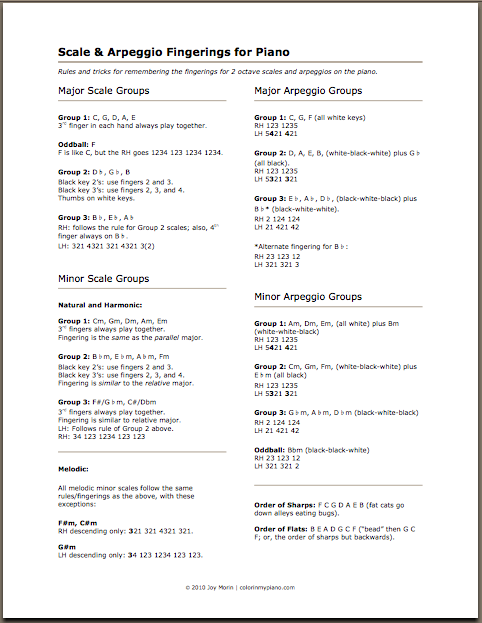 It’s been a few weeks since I’ve added a new printable to the Printables page….so here’s one I created a couple of months ago. You can find it on the Printables > Other Resources page.
It’s been a few weeks since I’ve added a new printable to the Printables page….so here’s one I created a couple of months ago. You can find it on the Printables > Other Resources page.
Scale and Arpeggio Fingering (2 Octaves) Reference Sheet (3 pages long)
I created this printable with my intermediate/advanced students in mind who are working on 2- and 4- octave scales/arpeggios and have trouble keeping all their fingerings straight in their head once they start getting them under their fingers. It’s nice to have a guide tucked inside the front cover of a book to refer to now and then!
The document contains three pages:
Page 1: Rules and tricks for remembering scale and arpeggio fingerings (as shown on the right).
Page 2: A listing of the fingerings for each Major and Harmonic Minor scale/arpeggio (2-octave) for piano.
Page 3: A continuation of page 2.
Of course, there are a few different ways to finger scales and arpeggios, so I’m sorry if the fingerings listed in this printable do not correspond with the ones you prefer to teach your students. These are the ones I like to use, and I thought I’d share it with anyone who might happen to find it useful.
I did my best to proof-read the fingerings, but it is certainly possible that I may have missed something….so if you encounter something that seems sketchy, please let me know!



Hi Joy!
I went over the scale/arpeggio sheet as a refresher for myself; I also plan to pass it out to students for reference. I did notice a few things you might wish to adjust:
1) Consistently list both enharmonic keys–Group 2 Major scales, arpeggios, etc.
2) Re: minor keys–I don’t believe Gbm & Dbm are in the book (no enharmonic)
3) Re: minor scales (Group 2) G#m crosses with the 4th (C#) ascending in both
harmonic & melodic.
4) Re: minor scales (Group 3) F#m “3’s” do not play together on melodic.
5) Melodic: F#m, C#m RH descending–needs two more finger #’s (4-3 OR 3-2).
6) Minor Arpeggios (Group 2) Left Hand — finger 4 on the flat would be more
comfortable (the majors of this group use 4; the black note is even lower).
7) Minor Arpeggios (Group 3) – Key name adjustments
Thank you for all the wonderful information you provide regularly! You make my job so much easier!
Kathy! Thank you so much for the time you took in finding these inconsistencies. I knew there would be some things to change, and I really needed another pair of eyes to help with this! I will try to revise this soon and re-post. (I’ll probably wait until after I survive exams next week…) Thanks again.